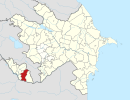Əbrəqunus
Əbrəqunus | |
|---|---|
Municipality | |
| Coordinates: 39°08′06″N 45°38′13″E / 39.13500°N 45.63694°E | |
| Country | |
| Autonomous republic | Nakhchivan |
| Rayon | Julfa |
| Population | |
| • Total | 2,747 |
| Time zone | UTC+4 (AZT) |
| • Summer (DST) | UTC+5 (AZT) |
Əbrəqunus (also, Əbrəqunis, Əbrəkunis, and Abrakunis) is a village and municipality in the Julfa Rayon of Nakhchivan, Azerbaijan. It has a population of 2,747.
History
A legend connects the settlement's name to an Armenian patriarch named Arbak.[citation needed]
A medieval Armenian monastery called Surp Karapet was located in Abrakunis. It stood intact but derelict until shortly before 2005, when it was demolished and entirely destroyed[1]. The main church in the monastery was built in 1381 over the ruins of an older church. Internally, it was a domed basilica with four piers. The lower parts of the church were built of cut stone, but the dome and its tall drum were of brick and from a later repair. The interior had some Persian-style frescoes from the 1740s. On the exterior walls were various relief carvings – crosses, eagles, etc. Beside the south wall was a small chapel dedicated to St. Stephanos; in 1705 a bell tower was added to the roof of this chapel.[2] The monastery had a fortified enclosure wall made of mud brick. Beside the entrance to the church was a khachkar with an inscription dated 1074.[citation needed]
References
- ^ Maghakyan, Simon; Pickman, Sarah (18 February 2019). "A Regime Conceals Its Erasure of Indigenous Armenian Culture". Hyperallergic. Hyperallergic. Retrieved 30 June 2020.
- ^ Switzerland-Armenia Parliamentary Group (ed.) "The destruction of Jugha", Bern, 2006. p73-74.


